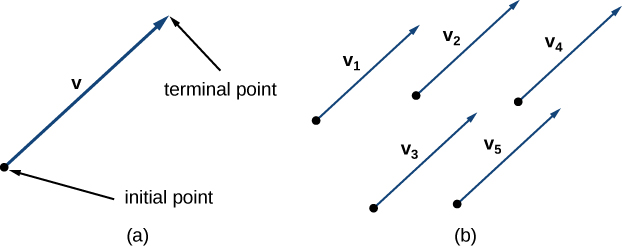
When describing the movement of an airplane in flight, it is important to communicate two pieces of information: the direction in which the plane is traveling and the plane’s speed. When measuring a force, such as the thrust of the plane’s engines, it is important to describe not only the strength of that force, but also the direction in which it is applied. Some quantities, such as or force, are defined in terms of both size (also called magnitude) and direction. A quantity that has magnitude and direction is called a vector. In this text, we denote vectors by boldface letters, such as v.
A vector is a quantity that has both magnitude and direction.
A vector in a plane is represented by a directed line segment (an arrow). The endpoints of the segment are called the initial point and the terminal point of the vector. An arrow from the initial point to the terminal point indicates the direction of the vector. The length of the line segment represents its magnitude. We use the notation
to denote the magnitude of the vector
A vector with an initial point and terminal point that are the same is called the zero vector, denoted
The zero vector is the only vector without a direction, and by convention can be considered to have any direction convenient to the problem at hand.
Vectors with the same magnitude and direction are called equivalent vectors. We treat equivalent vectors as equal, even if they have different initial points. Thus, if
and
are equivalent, we write
Vectors are said to be equivalent vectors if they have the same magnitude and direction.
The arrows in [link](b) are equivalent. Each arrow has the same length and direction. A closely related concept is the idea of parallel vectors. Two vectors are said to be parallel if they have the same or opposite directions. We explore this idea in more detail later in the chapter. A vector is defined by its magnitude and direction, regardless of where its initial point is located.

The use of boldface, lowercase letters to name vectors is a common representation in print, but there are alternative notations. When writing the name of a vector by hand, for example, it is easier to sketch an arrow over the variable than to simulate boldface type:
When a vector has initial point
and terminal point
the notation
is useful because it indicates the direction and location of the vector.
Sketch a vector in the plane from initial point
to terminal point
Sketch the vector
where
is point
and
is point
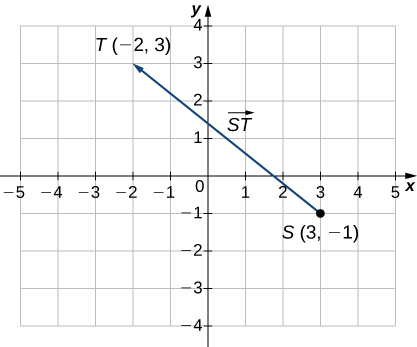
The first point listed in the name of the vector is the initial point of the vector.
Vectors have many real-life applications, including situations involving force or velocity. For example, consider the forces acting on a boat crossing a river. The boat’s motor generates a force in one direction, and the current of the river generates a force in another direction. Both forces are vectors. We must take both the magnitude and direction of each force into account if we want to know where the boat will go.
A second example that involves vectors is a quarterback throwing a football. The quarterback does not throw the ball parallel to the ground; instead, he aims up into the air. The velocity of his throw can be represented by a vector. If we know how hard he throws the ball (magnitude—in this case, speed), and the angle (direction), we can tell how far the ball will travel down the field.
A real number is often called a scalar in mathematics and physics. Unlike vectors, scalars are generally considered to have a magnitude only, but no direction. Multiplying a vector by a scalar changes the vector’s magnitude. This is called scalar multiplication. Note that changing the magnitude of a vector does not indicate a change in its direction. For example, wind blowing from north to south might increase or decrease in speed while maintaining its direction from north to south.
The product
of a vector v and a scalar k is a vector with a magnitude that is
times the magnitude of
and with a direction that is the same as the direction of
if
and opposite the direction of
if
This is called scalar multiplication. If
or
then
As you might expect, if
we denote the product
as
Note that
has the same magnitude as
but has the opposite direction ([link]).
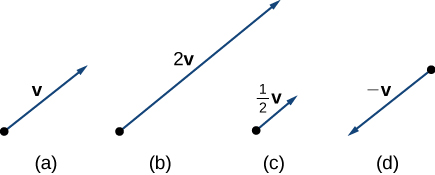
Another operation we can perform on vectors is to add them together in vector addition, but because each vector may have its own direction, the process is different from adding two numbers. The most common graphical method for adding two vectors is to place the initial point of the second vector at the terminal point of the first, as in [link](a). To see why this makes sense, suppose, for example, that both vectors represent displacement. If an object moves first from the initial point to the terminal point of vector
then from the initial point to the terminal point of vector
the overall displacement is the same as if the object had made just one movement from the initial point to the terminal point of the vector
For obvious reasons, this approach is called the triangle method. Notice that if we had switched the order, so that
was our first vector and v was our second vector, we would have ended up in the same place. (Again, see [link](a).) Thus,
A second method for adding vectors is called the parallelogram method. With this method, we place the two vectors so they have the same initial point, and then we draw a parallelogram with the vectors as two adjacent sides, as in [link](b). The length of the diagonal of the parallelogram is the sum. Comparing [link](b) and [link](a), we can see that we get the same answer using either method. The vector
is called the vector sum.
The sum of two vectors
and
can be constructed graphically by placing the initial point of
at the terminal point of
Then, the vector sum,
is the vector with an initial point that coincides with the initial point of
and has a terminal point that coincides with the terminal point of
This operation is known as vector addition.
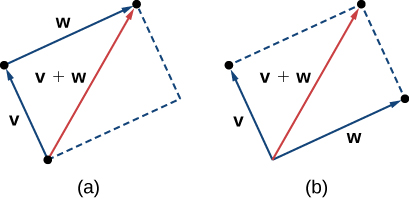
It is also appropriate here to discuss vector subtraction. We define
as
The vector
is called the vector difference. Graphically, the vector
is depicted by drawing a vector from the terminal point of
to the terminal point of
([link]).
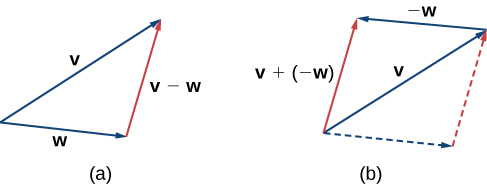
In [link](a), the initial point of
is the initial point of
The terminal point of
is the terminal point of
These three vectors form the sides of a triangle. It follows that the length of any one side is less than the sum of the lengths of the remaining sides. So we have
This is known more generally as the triangle inequality. There is one case, however, when the resultant vector
has the same magnitude as the sum of the magnitudes of
and
This happens only when
and
have the same direction.
has the same direction as
it is three times as long as
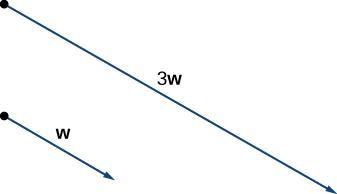
Vector
has the same direction as
and is three times as long.
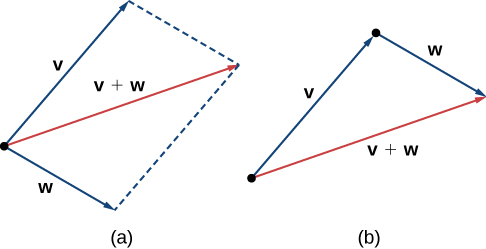
we can first rewrite the expression as
Then we can draw the vector
then add it to the vector
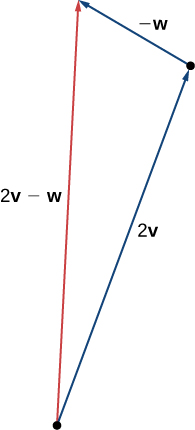
Working with vectors in a plane is easier when we are working in a coordinate system. When the initial points and terminal points of vectors are given in Cartesian coordinates, computations become straightforward.
Are
and
equivalent vectors?
has initial point
and terminal point
has initial point
and terminal point
has initial point
and terminal point
has initial point
and terminal point
Which of the following vectors are equivalent?

Vectors
and
are equivalent.
Equivalent vectors have both the same magnitude and the same direction.
We have seen how to plot a vector when we are given an initial point and a terminal point. However, because a vector can be placed anywhere in a plane, it may be easier to perform calculations with a vector when its initial point coincides with the origin. We call a vector with its initial point at the origin a standard-position vector. Because the initial point of any vector in standard position is known to be
we can describe the vector by looking at the coordinates of its terminal point. Thus, if vector v has its initial point at the origin and its terminal point at
we write the vector in component form as
When a vector is written in component form like this, the scalars x and y are called the components of
The vector with initial point
and terminal point
can be written in component form as
The scalars
and
are called the components of
Recall that vectors are named with lowercase letters in bold type or by drawing an arrow over their name. We have also learned that we can name a vector by its component form, with the coordinates of its terminal point in angle brackets. However, when writing the component form of a vector, it is important to distinguish between
and
The first ordered pair uses angle brackets to describe a vector, whereas the second uses parentheses to describe a point in a plane. The initial point of
is
the terminal point of
is
When we have a vector not already in standard position, we can determine its component form in one of two ways. We can use a geometric approach, in which we sketch the vector in the coordinate plane, and then sketch an equivalent standard-position vector. Alternatively, we can find it algebraically, using the coordinates of the initial point and the terminal point. To find it algebraically, we subtract the x-coordinate of the initial point from the x-coordinate of the terminal point to get the x component, and we subtract the y-coordinate of the initial point from the y-coordinate of the terminal point to get the y component.
Let v be a vector with initial point
and terminal point
Then we can express v in component form as
Express vector
with initial point
and terminal point
in component form.
and terminal point
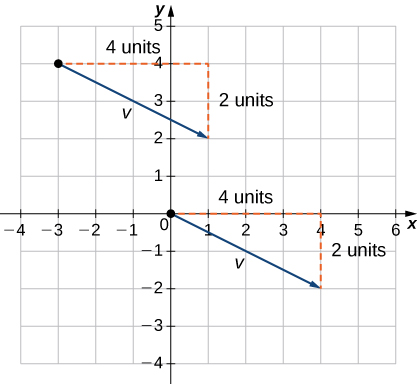
In the first solution, we used a sketch of the vector to see that the terminal point lies 4 units to the right. We can accomplish this algebraically by finding the difference of the x-coordinates:
Similarly, the difference of the y-coordinates shows the vertical length of the vector.
So, in component form,
Vector
has initial point
and terminal point
Express
in component form.
You may use either geometric or algebraic method.
To find the magnitude of a vector, we calculate the distance between its initial point and its terminal point. The magnitude of vector
is denoted
or
and can be computed using the formula
Note that because this vector is written in component form, it is equivalent to a vector in standard position, with its initial point at the origin and terminal point
Thus, it suffices to calculate the magnitude of the vector in standard position. Using the distance formula to calculate the distance between initial point
and terminal point
we have
Based on this formula, it is clear that for any vector
and
if and only if
The magnitude of a vector can also be derived using the Pythagorean theorem, as in the following figure.
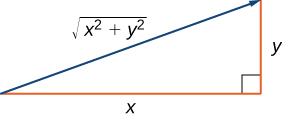
We have defined scalar multiplication and vector addition geometrically. Expressing vectors in component form allows us to perform these same operations algebraically.
Let
and
be vectors, and let
be a scalar.
Scalar multiplication:
Vector addition:
Let
be the vector with initial point
and terminal point
and let
in component form and find
Then, using algebra, find
and
at the origin, we must translate the vector
units to the left and
units down ([link]). Using the algebraic method, we can express
as
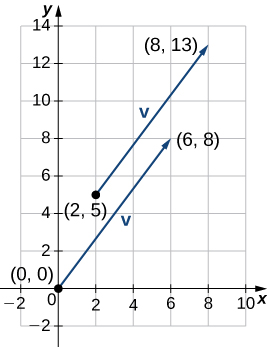
add the x-components and the y-components separately:
multiply
by the scalar
find
and add it to
Let
and let
be the vector with initial point
and terminal point
in component form.
a.
b.
c.
Use the Pythagorean Theorem to find
To find
start by finding the scalar multiples
and
Now that we have established the basic rules of vector arithmetic, we can state the properties of vector operations. We will prove two of these properties. The others can be proved in a similar manner.
Let
be vectors in a plane. Let
be scalars.
Let
and
Apply the commutative property for real numbers:
□
Apply the distributive property for real numbers:
□
Prove the additive inverse property.
Use the component form of the vectors.
We have found the components of a vector given its initial and terminal points. In some cases, we may only have the magnitude and direction of a vector, not the points. For these vectors, we can identify the horizontal and vertical components using trigonometry ([link]).
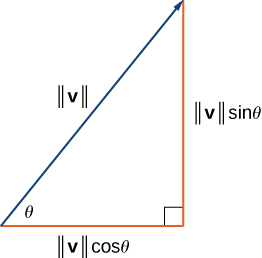
Consider the angle
formed by the vector v and the positive x-axis. We can see from the triangle that the components of vector
are
Therefore, given an angle and the magnitude of a vector, we can use the cosine and sine of the angle to find the components of the vector.
Find the component form of a vector with magnitude 4 that forms an angle of
with the x-axis.
Let
and
represent the components of the vector ([link]). Then
and
The component form of the vector is
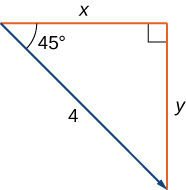
Find the component form of vector
with magnitude
that forms an angle of
with the positive x-axis.
and
A unit vector is a vector with magnitude
For any nonzero vector
we can use scalar multiplication to find a unit vector
that has the same direction as
To do this, we multiply the vector by the reciprocal of its magnitude:
Recall that when we defined scalar multiplication, we noted that
For
it follows that
We say that
is the unit vector in the direction of
([link]). The process of using scalar multiplication to find a unit vector with a given direction is called normalization.

Let
with the same direction as
such that
then divide the components of
by the magnitude:
is in the same direction as
and
Use scalar multiplication to increase the length of
without changing direction:
Let
Find a vector with magnitude
in the opposite direction as
First, find a unit vector in the same direction as
We have seen how convenient it can be to write a vector in component form. Sometimes, though, it is more convenient to write a vector as a sum of a horizontal vector and a vertical vector. To make this easier, let’s look at standard unit vectors. The standard unit vectors are the vectors
and
([link]).
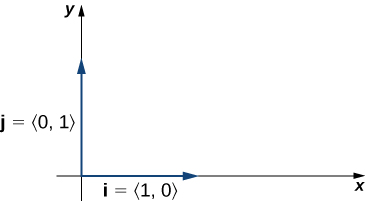
By applying the properties of vectors, it is possible to express any vector in terms of
and
in what we call a linear combination:
Thus,
is the sum of a horizontal vector with magnitude
and a vertical vector with magnitude
as in the following figure.
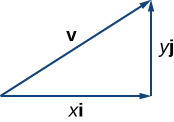
in terms of standard unit vectors.
is a unit vector that forms an angle of
with the positive x-axis. Use standard unit vectors to describe
into a vector with a zero y-component and a vector with a zero x-component:
is a unit vector, the terminal point lies on the unit circle when the vector is placed in standard position ([link]).
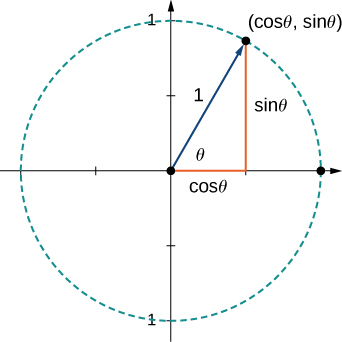
Let
and let
be a unit vector that forms an angle of
with the positive x-axis. Express
and
in terms of the standard unit vectors.
Use sine and cosine to find the components of
Because vectors have both direction and magnitude, they are valuable tools for solving problems involving such applications as motion and force. Recall the boat example and the quarterback example we described earlier. Here we look at two other examples in detail.
Jane’s car is stuck in the mud. Lisa and Jed come along in a truck to help pull her out. They attach one end of a tow strap to the front of the car and the other end to the truck’s trailer hitch, and the truck starts to pull. Meanwhile, Jane and Jed get behind the car and push. The truck generates a horizontal force of
lb on the car. Jane and Jed are pushing at a slight upward angle and generate a force of
lb on the car. These forces can be represented by vectors, as shown in [link]. The angle between these vectors is
Find the resultant force (the vector sum) and give its magnitude to the nearest tenth of a pound and its direction angle from the positive x-axis.

To find the effect of combining the two forces, add their representative vectors. First, express each vector in component form or in terms of the standard unit vectors. For this purpose, it is easiest if we align one of the vectors with the positive x-axis. The horizontal vector, then, has initial point
and terminal point
It can be expressed as
or
The second vector has magnitude
and makes an angle of
with the first, so we can express it as
or
Then, the sum of the vectors, or resultant vector, is
and we have
The angle
made by
and the positive x-axis has
so
which means the resultant force
has an angle of
above the horizontal axis.
An airplane flies due west at an airspeed of
mph. The wind is blowing from the northeast at
mph. What is the ground speed of the airplane? What is the bearing of the airplane?
Let’s start by sketching the situation described ([link]).
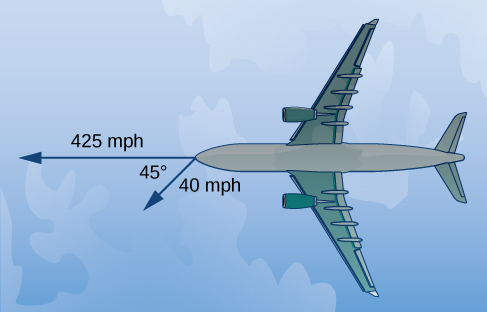
Set up a sketch so that the initial points of the vectors lie at the origin. Then, the plane’s velocity vector is
The vector describing the wind makes an angle of
with the positive x-axis:
When the airspeed and the wind act together on the plane, we can add their vectors to find the resultant force:
The magnitude of the resultant vector shows the effect of the wind on the ground speed of the airplane:
As a result of the wind, the plane is traveling at approximately
mph relative to the ground.
To determine the bearing of the airplane, we want to find the direction of the vector
The overall direction of the plane is
south of west.
An airplane flies due north at an airspeed of
mph. The wind is blowing from the northwest at
mph. What is the ground speed of the airplane?
Approximately
mph
Sketch the vectors with the same initial point and find their sum.
has magnitude
and can be found by dividing a vector by its magnitude:
The standard unit vectors are
A vector
can be expressed in terms of the standard unit vectors as
For the following exercises, consider points
and
Determine the requested vectors and express each of them a. in component form and b. by using the standard unit vectors.
a.
b.
a.
b.
a.
b.
a.
b.
The unit vector in the direction of
a.
b.
The unit vector in the direction of
A vector
has initial point
and terminal point
Find the unit vector in the direction of
Express the answer in component form.
A vector
has initial point
and terminal point
Find the unit vector in the direction of
Express the answer in component form.
The vector
has initial point
and terminal point
that is on the y-axis and above the initial point. Find the coordinates of terminal point
such that the magnitude of the vector
is
The vector
has initial point
and terminal point
that is on the x-axis and left of the initial point. Find the coordinates of terminal point
such that the magnitude of the vector
is
For the following exercises, use the given vectors
and
and express it in both the component form and by using the standard unit vectors.
and express it in both the component form and by using the standard unit vectors.
and
and, respectively,
and
satisfy the triangle inequality.
and
Express the vectors in both the component form and by using standard unit vectors.
a.
b.
c. Answers will vary; d.
Let
be a standard-position vector with terminal point
Let
be a vector with initial point
and terminal point
Find the magnitude of vector
Let
be a standard-position vector with terminal point at
Let
be a vector with initial point
and terminal point
Find the magnitude of vector
Let
and
be two nonzero vectors that are nonequivalent. Consider the vectors
and
defined in terms of
and
Find the scalar
such that vectors
and
are equivalent.
Let
and
be two nonzero vectors that are nonequivalent. Consider the vectors
and
defined in terms of
and
Find the scalars
and
such that vectors
and
are equivalent.
Consider the vector
with components that depend on a real number
As the number
varies, the components of
change as well, depending on the functions that define them.
and
in component form.
of vector
remains constant for any real number
varies, show that the terminal point of vector
describes a circle centered at the origin of radius
a.
b. Answers may vary; c. Answers may vary
Consider vector
with components that depend on a real number
As the number
varies, the components of
change as well, depending on the functions that define them.
and
in component form.
of vector
remains constant for any real number
varies, show that the terminal point of vector
describes a circle centered at the origin of radius
Show that vectors
and
are equivalent for
and
where
is an integer.
Answers may vary
Show that vectors
and
are opposite for
and
where
is an integer.
For the following exercises, find vector
with the given magnitude and in the same direction as vector
For the following exercises, find the component form of vector
given its magnitude and the angle the vector makes with the positive x-axis. Give exact answers when possible.
For the following exercises, vector
is given. Find the angle
that vector
makes with the positive direction of the x-axis, in a counter-clockwise direction.
Let
and
be three nonzero vectors. If
then show there are two scalars,
and
such that
Answers may vary
Consider vectors
and c = 0 Determine the scalars
and
such that
Let
be a fixed point on the graph of the differential function
with a domain that is the set of real numbers.
such that point
is situated on the line tangent to the graph of
at point
with initial point
and terminal point
a.
b.
Consider the function
where
such that point
s situated on the line tangent to the graph of
at point
with initial point
and terminal point
Consider
and
two functions defined on the same set of real numbers
Let
and
be two vectors that describe the graphs of the functions, where
Show that if the graphs of the functions
and
do not intersect, then the vectors
and
are not equivalent.
Find
such that vectors
and
are equivalent.
Calculate the coordinates of point
such that
is a parallelogram, with
and
Consider the points
and
Determine the component form of vector
The speed of an object is the magnitude of its related velocity vector. A football thrown by a quarterback has an initial speed of
mph and an angle of elevation of
Determine the velocity vector in mph and express it in component form. (Round to two decimal places.)
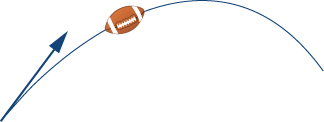
A baseball player throws a baseball at an angle of
with the horizontal. If the initial speed of the ball is
mph, find the horizontal and vertical components of the initial velocity vector of the baseball. (Round to two decimal places.)
A bullet is fired with an initial velocity of
ft/sec at an angle of
with the horizontal. Find the horizontal and vertical components of the velocity vector of the bullet. (Round to two decimal places.)
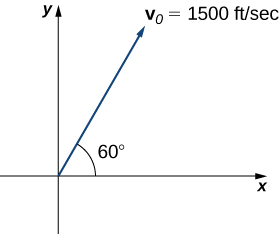
The horizontal and vertical components are
ft/sec and
ft/sec, respectively.
[T] A 65-kg sprinter exerts a force of
N at a
angle with respect to the ground on the starting block at the instant a race begins. Find the horizontal component of the force. (Round to two decimal places.)
[T] Two forces, a horizontal force of
lb and another of
lb, act on the same object. The angle between these forces is
Find the magnitude and direction angle from the positive x-axis of the resultant force that acts on the object. (Round to two decimal places.)
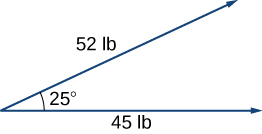
The magnitude of resultant force is
lb; the direction angle is
[T] Two forces, a vertical force of
lb and another of
lb, act on the same object. The angle between these forces is
Find the magnitude and direction angle from the positive x-axis of the resultant force that acts on the object. (Round to two decimal places.)
[T] Three forces act on object. Two of the forces have the magnitudes
N and
N, and make angles
and
respectively, with the positive x-axis. Find the magnitude and the direction angle from the positive x-axis of the third force such that the resultant force acting on the object is zero. (Round to two decimal places.)
The magnitude of the third vector is
N; the direction angle is
Three forces with magnitudes
lb,
lb, and
lb act on an object at angles of
and
respectively, with the positive x-axis. Find the magnitude and direction angle from the positive x-axis of the resultant force. (Round to two decimal places.)

[T] An airplane is flying in the direction of
east of north (also abbreviated as
at a speed of
mph. A wind with speed
mph comes from the southwest at a bearing of
What are the ground speed and new direction of the airplane?
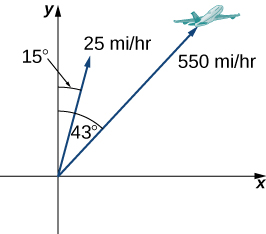
The new ground speed of the airplane is
mph; the new direction is
[T] A boat is traveling in the water at
mph in a direction of
(that is,
east of north). A strong current is moving at
mph in a direction of
What are the new speed and direction of the boat?
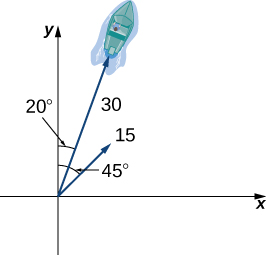
[T] A 50-lb weight is hung by a cable so that the two portions of the cable make angles of
and
respectively, with the horizontal. Find the magnitudes of the forces of tension
and
in the cables if the resultant force acting on the object is zero. (Round to two decimal places.)
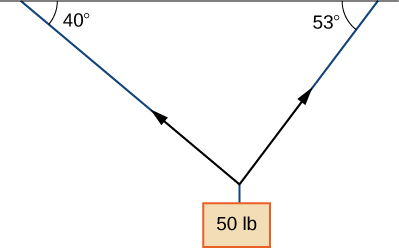
[T] A 62-lb weight hangs from a rope that makes the angles of
and
respectively, with the horizontal. Find the magnitudes of the forces of tension
and
in the cables if the resultant force acting on the object is zero. (Round to two decimal places.)
[T] A 1500-lb boat is parked on a ramp that makes an angle of
with the horizontal. The boat’s weight vector points downward and is a sum of two vectors: a horizontal vector
that is parallel to the ramp and a vertical vector
that is perpendicular to the inclined surface. The magnitudes of vectors
and
are the horizontal and vertical component, respectively, of the boat’s weight vector. Find the magnitudes of
and
(Round to the nearest integer.)
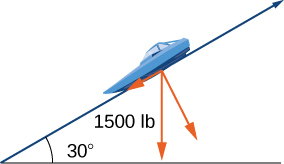
lb,
lb
[T] An 85-lb box is at rest on a
incline. Determine the magnitude of the force parallel to the incline necessary to keep the box from sliding. (Round to the nearest integer.)
A guy-wire supports a pole that is
ft high. One end of the wire is attached to the top of the pole and the other end is anchored to the ground
ft from the base of the pole. Determine the horizontal and vertical components of the force of tension in the wire if its magnitude is
lb. (Round to the nearest integer.)
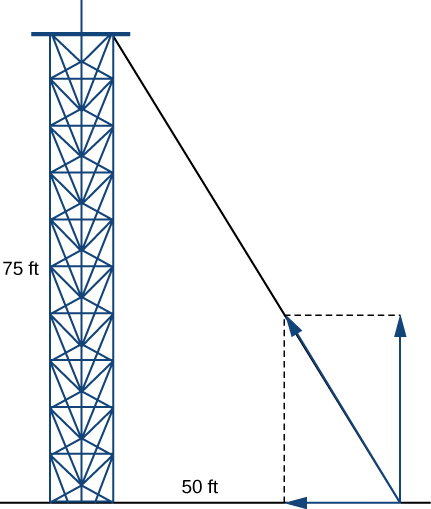
The two horizontal and vertical components of the force of tension are
lb and
lb, respectively.
A telephone pole guy-wire has an angle of elevation of
with respect to the ground. The force of tension in the guy-wire is
lb. Find the horizontal and vertical components of the force of tension. (Round to the nearest integer.)
is defined as
and
can be constructed graphically by placing the initial point of
at the terminal point of
then the vector sum
is the vector with an initial point that coincides with the initial point of
and with a terminal point that coincides with the terminal point of

You can also download for free at http://cnx.org/contents/9a1df55a-b167-4736-b5ad-15d996704270@5.1
Attribution: